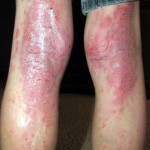Many things can cause allergic skin reactions, such as foods, environmental factors (dust mites, pets, etc), medications, poison ivy, cosmetics, metals, etc, just to name a few. Allergic rashes vary in onset, appearance, duration, and response to treatment.
Allergic eczema (atopic dermatitis), contact dermatitis, hives and swelling (urticaria and angioedema) are the most common types of skin rashes that may have (but not necessarily) allergic triggers.
 Eczema skin looks red, dry, and irritated, and is itchy. In severe cases, small fluid-filled blisters may develop and ooze.
Eczema skin looks red, dry, and irritated, and is itchy. In severe cases, small fluid-filled blisters may develop and ooze.
 Contact dermatitis usually occurs at the site of direct skin contact with an irritant or allergen. Rash may take days to develop. The inflamed skin can be red, dry, cracked or peeling-off, and may develop tiny blisters, drain fluid, and crust over.
Contact dermatitis usually occurs at the site of direct skin contact with an irritant or allergen. Rash may take days to develop. The inflamed skin can be red, dry, cracked or peeling-off, and may develop tiny blisters, drain fluid, and crust over.
 Hives (urticaria) are swollen, raised, red skin welts. Very often they come together with swelling from deep skin or mucosa (angioedema).
Hives (urticaria) are swollen, raised, red skin welts. Very often they come together with swelling from deep skin or mucosa (angioedema).
Details of these allergic skin conditions are discussed individually.